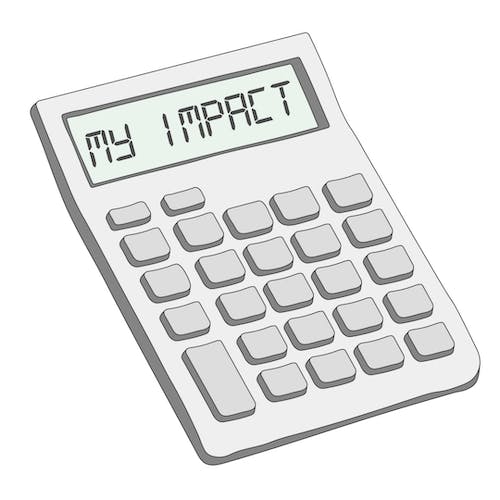Our new impact methodology
Every year, a third of all food grown globally is wasted. We grow food that we throw away, only to grow it again. This cycle requires resources. A lot of them. Water, energy, land, time. All of which are wasted when food isn’t eaten.
If we only grew what we needed, we would dramatically reduce our impact on the environment. The 25% of the world’s fresh water used to grow food that is never eaten would be saved. The 8% of global greenhouse gas emissions caused by food waste would be prevented.
According to the Drawdown Project, fighting food waste is the number one solution to reverse the climate crisis and stop the planet from getting 2°C warmer by the year 2100. Each week, we come together on a mission to do this. Our methodology exists to show you how you’re helping save the planet every time you pick up your box from your doorstep.
Over the past year, we have been improving our maths and are beyond excited to share with you our improved calculations. It allows us to tell you your impact - down to each product, in every box, for every week - and lets us better understand our collective impact as a community too.

THE IMPROVEMENTS
If you’ve been with us for a while, you might have seen your numbers before. Here’s what we’ve improved:
- We use a new data set to measure the carbon emissions and water use of different fruits and veg eaten in the UK: in academic terms, life cycle assessment data. Essentially this allows us to understand the impact of all the resources that went into growing an apple or a potato, for example, all the water for irrigation, all the electricity to run the processing and packaging facilities and all the fuel for transporting the types of fruit & veg we stock.
- We deduct our own carbon footprint: all the emissions from deliveries and pickups, the production of our boxes and the running of our warehouse in total and per box have been accounted for.
- We deduct the carbon emissions associated with other food waste destinations: if the fruit and vegetables we save could have been repurposed to animal feed, anaerobic digestion, or ploughed back into the field, we don’t claim it within our figures.
THE PROCESS
To understand how to better measure our impact, we needed to:
- Learn what has been done before: how are experts measuring the impact of fruit & veg?
- Understand what you care about: what numbers you want to see and what metrics make sense to you. It was lovely meeting some of you in focus groups (thank you so much)!
- Work with the best: we have been working with Advance London, specialists in impact measurement and food waste, who guided us on our approach and model throughout this process.
THE FORMULA
Our impact calculations work out how much fruit and veg you’ve rescued, and therefore the amount of carbon emissions and water used to grow it you have saved in the process.
We calculate personalised impact figures based on the specific contents of each box. We do this weekly, looking at the weight of each box type and the carbon emissions and water saved based on the specific weight of each item rescued. We calculate a per box operational carbon footprint and take this off the total amount of carbon emissions saved. We also deduct the net emissions of the food going to other destinations.
Your impact (based on the total amount of fruit & veg rescued)
=
(Carbon Emissions Avoided + Water Waste Avoided)
-
(Operational Carbon Emissions - Carbon Emissions of Other Food Destinations)
THE KEY VARIABLES & METRICS
- Fruit & veg in kilograms (kg) that you rescue: this is calculated based on the total weight of each product in each box size, each week.
- Carbon emissions (CO2e) avoided: we use academic life cycle assessment data to measure this. This study measures the CO2e emissions for a range of fruit and vegetables across its lifecycle, i.e. Farm → post-harvest → storage → processing → packaging → ripening → transport → retail.
- Water wastage in litres (L) avoided: we look at the academic life cycle assessment data here too.
- ODDBOX carbon emissions (CO2e) footprint: we deduct the carbon emissions of our operations and convert them into CO2e using academic data. Here’s what we account for:
undefinedundefinedundefined - Carbon emissions (CO2e) of other food waste destinations: we deduct the carbon emissions of fruit & veg we save that could have been repurposed to animal feed, anaerobic digestion, or ploughed back into the field. We use academic data to work out the percentages.
YOUR NUMBERS
Here’s what you’ll see:
- The amount of fruit and veg that you rescued from going to waste;
- The carbon emissions that you prevented and the water waste that you avoided by rescuing food already grown, and preventing them from needlessly having to be grown again.
THE FUTURE PLAN
Improve, improve, improve! Here are some of the things we have in our pipeline:
- Personalised impact reports: we want to know how often you want to see this, so we are following up with you to understand that soon. We want you to be able to see your impact when you want.
- Setting targets to cut our carbon footprint further: we have a net positive impact, but we’re always looking to get better. We are currently setting goals and planning further actions to reduce our carbon footprint even further and will keep you updated.
- We want to hear from you: we couldn’t make the difference we do without you - whether you want to share ideas or have a question about our new methodology, our ears are always open - just drop us a message below in the comment section, on social or at hello@oddbox.co.uk!
THE ASSUMPTIONS & LIMITATIONS
We want to call out a) some of our assumptions and b) some of the limitations in our maths. We will continue improving the accuracy of our data, and we will take you on that journey too.
- The academic study for lifecycle assessments we use covers 38 different varieties of fruit and vegetables. At ODDBOX, we source more than 90 items. Therefore, for those not listed in the academic study we have provided a proxy to offer the closest match in terms of the resources required to grow it.
- Lifecycle data includes all stages of a product’s life; from farming, storage, processing, packaging, transport, retail, household and waste. For our calculations, we have used lifecycle data from farm to retail stages only - we have excluded the carbon emissions and water use data from the household and waste stages, as this is not within our control.
- Our water footprint as an organisation is very small, so we do not consider this in the same way we do with carbon emissions.
- The information on which we have based our analysis about food waste destinations at farm level is from WRAP’s Food Waste in Primary Production report, but this is a notoriously difficult area to measure. We intend to more formally measure the destinations of food waste with our own suppliers in the future and feed this into our calculations.
- We started tracking our carbon footprint towards the end of 2019. Although we were able to collect a lot of data for the whole year, there are a few data points where we could not track our activity over the year. For example with car mileage, we have had to estimate based on a week of data in Jan 2020.
- We calculate personalised impact figures in two ways. Pre-2020, we calculated the average impact for each box size, based on the average CO2e and water use figures, and multiplied that by the number of box types each individual has bought. 2020 onwards we calculate impact weekly depending on what produce is in each box. We then calculate your individual impact based on what box type they bought in a certain week so that you have impact figures based on actual box composition. These two figures are then added up.
REFERENCES
In case you want to continue reading:
- 25% of the world’s freshwater is used to grow food that is wasted can be found in Hall et al., The Progressive Increase of Food Waste in America and Its Environmental Impact, 2007
- Food waste accounts for 8% of global greenhouse gas emissions can be found in FAO, Food Wastage footprints & climate change, 2015
- The data source for Lifecycle Assessment Data we use is Environmental impacts of vegetables consumption in the UK and Life cycle environmental impacts of fruits consumption in the UK by Angelina Frankowska, Harish Kumar Jeswani, Adisa Azapagic, 2019;
- We use the DEFRA conversion factors to convert these into carbon emissions equivalent figures https://www.gov.uk/government/publications/greenhouse-gas-reporting-conversion-factors-2020;
- We use WRAP Primary Production report 2019 and the WRAP Primary Production Database to calculate the percentage of fruit and vegetables that are wasted in the UK and the destinations of that waste;
- We use the academic report on Greenhouse gas emissions of food waste disposal options for UK retailers by J.A. Moulta, S.R. Allanc, C.N. Hewitta, M. Berners-Leeb, 2018 to measure the CO2e associated with different food waste disposal options.
Did you make it until here? Thank you so much! It means the world to us and we would *love* to hear from you. Comment below any thoughts, ideas, dreams…!

